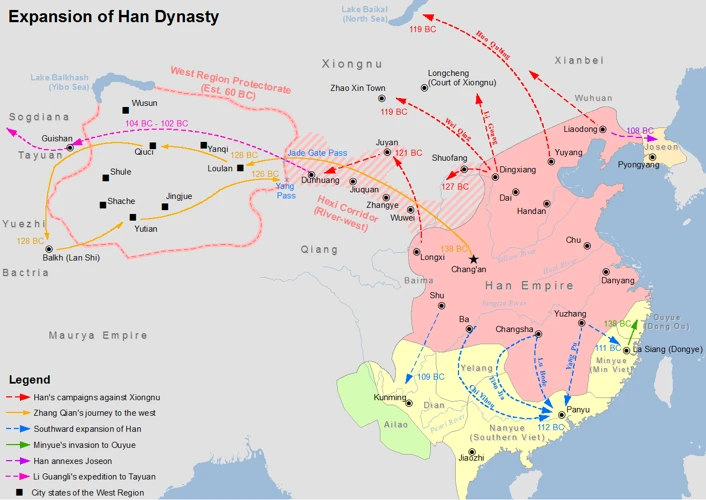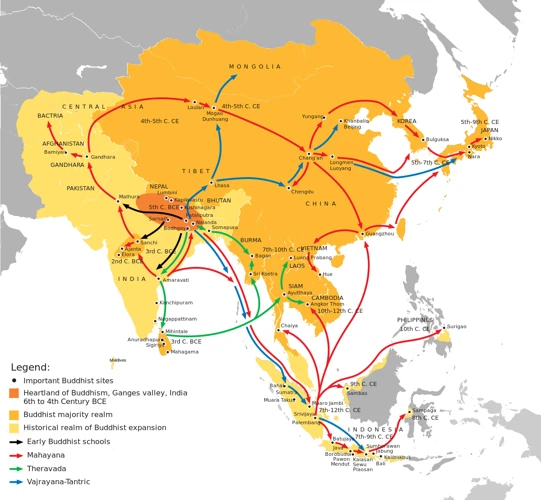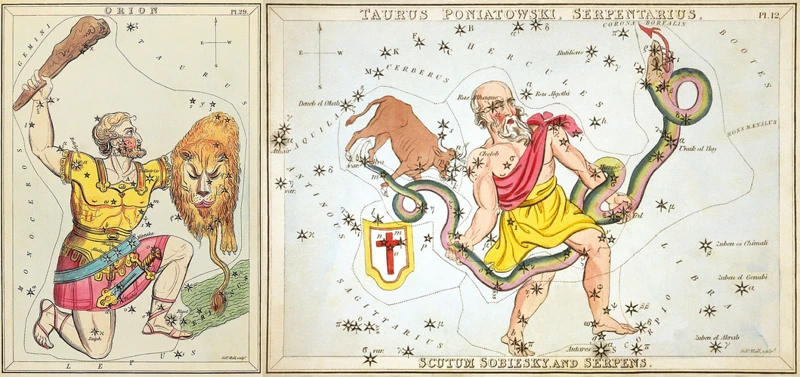When we think of ancient trade routes, the Silk Road immediately comes to mind. This network of pathways and connections stretching across Asia and Europe played a crucial role in shaping the history of civilization. But have you ever wondered about the origins of the Silk Road? How did it come into existence and what were the forces that drove its growth? In this article, we will embark on a journey through time to trace the birth and evolution of the Silk Road, uncovering the fascinating stories of trade, diplomacy, and cultural exchange along the way. So sit back, join us on this adventure, and let’s delve into the captivating history of the Silk Road.
Contents
- The Birth of Silk
- The Han Dynasty and the Expansion of Trade
- The Connection of East and West
- The Kushan Empire and the Spread of Buddhism
- The Silk Road during the Roman Empire
- The Fall of the Silk Road
- Conclusion
-
Frequently Asked Questions
- 1. Why was silk considered such a valuable commodity in ancient times?
- 2. How did the Chinese protect the secret of silk production?
- 3. How was silk produced in ancient China?
- 4. What regions were involved in the trade of silk along the Silk Road?
- 5. Did the Silk Road only facilitate trade in silk?
- 6. What impact did the Silk Road have on cultural exchange?
- 7. Were there any dangers or challenges faced by traders on the Silk Road?
- 8. How did the Silk Road contribute to the spread of Buddhism?
- 9. Did the Roman Empire have a significant demand for silk?
- 10. When did the Silk Road begin to decline?
- References
-
Frequently Asked Questions
- 1. How did silk production begin?
- 2. What were the major trade goods exchanged on the Silk Road?
- 3. How long did it take to travel the entirety of the Silk Road?
- 4. How did trade routes change under the reign of the Han Dynasty?
- 5. What impact did the Silk Road have on the spread of Buddhism?
- 6. How did the Roman Empire contribute to the Silk Road’s success?
- 7. Why did the Silk Road decline?
- 8. Can we still trace the ancient trade routes of the Silk Road today?
- 9. What legacy did the Silk Road leave behind?
- 10. How has the Silk Road influenced modern trade and globalization?
- References
- Read More
The Birth of Silk

Silk, often associated with luxury and elegance, has a history that dates back over 4,000 years. Legend has it that the birth of silk can be attributed to the Empress Leizu of China. According to ancient Chinese mythology, the empress was sipping tea under a mulberry tree when a cocoon fell into her cup, unraveling to reveal a delicate and shimmering thread. Intrigued by its beauty and strength, she soon discovered that the source of this exquisite thread was the Bombyx mori silkworm.
The secret to silk production was closely guarded by the Chinese for centuries. It was considered an invaluable commodity, cherished not only for its luxurious feel, but also for its ability to symbolize status and wealth. Silk became the measure of trade and diplomacy in Ancient China, and its value grew to such an extent that it was eventually used as currency.
Silk production was carefully controlled by the Chinese empire. The silkworms were nurtured on mulberry leaves, and their cocoons were harvested and carefully unraveled to obtain the precious silk thread. This meticulous process made silk production labor-intensive and time-consuming, adding to its allure and exclusivity.
The demand for silk grew rapidly throughout China, and the lure of this luxurious fabric began to captivate neighboring regions. It wasn’t long before silk made its way along the trade routes, spreading its influence and enchanting people far beyond the borders of China.
The birth of silk marked the beginning of a remarkable journey that would shape the course of history. It was the catalyst for the development of extensive trade networks, the forging of diplomatic relationships, and the exchange of ideas and cultures. The Silk Road, with all its splendor and mystery, would not have existed without the humble silkworm and its remarkable creation.
Internal link: Exploring Ophiuchus and Healing Deities
The Han Dynasty and the Expansion of Trade

The Han Dynasty of China (206 BCE – 220 CE) played a pivotal role in the expansion of trade along the ancient Silk Road. Under the reign of Emperor Wu, the dynasty experienced a period of economic growth and territorial expansion. With a favorable political climate, the Han Dynasty established diplomatic relationships with neighboring regions, paving the way for a flourishing trade network.
During this time, the Han Dynasty implemented policies that encouraged international trade and supported the exchange of goods and ideas. The empire took advantage of its strategic location, acting as a bridge between the East and the West. This facilitated the movement of goods, such as silk, precious metals, spices, and exotic animals, along the Silk Road.
To ensure the safety and efficiency of trade, the Han Dynasty invested in the construction of roads and infrastructure. These infrastructure projects not only facilitated trade but also strengthened cultural exchanges and diplomatic ties. The Han Dynasty’s focus on promoting trade and diplomatic relations created an atmosphere of openness and cooperation, attracting merchants and travelers from distant lands.
One of the key factors that contributed to the expansion of trade during the Han Dynasty was the introduction of the caravan system. Caravans, consisting of merchants and their pack animals, traversed the treacherous terrains of the Silk Road, creating a network of trade routes that extended across vast distances. These caravans not only transported goods but also served as conduits for the exchange of knowledge, customs, and beliefs.
The Han Dynasty’s expansion of trade along the Silk Road had a profound impact on the development of civilizations across Asia and Europe. It fostered cultural diffusion and laid the foundation for lasting connections between diverse regions. The exchange of goods, ideas, and technologies transformed societies, shaping art, architecture, cuisine, and religious practices.
The Han Dynasty’s contribution to the expansion of trade along the Silk Road cannot be overstated. Their policies and infrastructure investments provided the necessary conditions for the growth and prosperity of this ancient trade network.
Internal link: Developing Strong Friendships with Ophiuchus: A Guide
The Connection of East and West

The connection between the East and the West was a pivotal moment in the history of the Silk Road. Trade routes began to form, linking distant lands and paving the way for cultural exchange, economic growth, and advancements in various fields. The Parthian Empire played a crucial role in establishing the initial connections, serving as a bridge between the two regions. The Parthians, skilled in horsemanship and trade, facilitated the movement of goods and ideas, allowing merchants and diplomats to traverse the vast landscapes. The trade routes expanded further during the Western Han Dynasty, when Emperor Wu sent an embassy to establish direct links with the West. This exchange of envoys laid the foundation for the flourishing trade that would characterize the Eastern Han Dynasty. These connections between the East and the West not only facilitated the exchange of goods, such as silk, spices, and precious metals, but also fostered the interchange of knowledge, ideas, and religious beliefs. The Silk Road became a vibrant and dynamic network that united distant civilizations, shaping the course of history.
Internal link: Developing Strong Friendships with Ophiuchus Guide
The Parthian Empire and the First Connections
The Parthian Empire, situated in what is now modern-day Iran and Iraq, played a crucial role in establishing the first connections along the Silk Road. As a powerful empire that spanned from the 3rd century BCE to the 3rd century CE, the Parthians were renowned for their military prowess and strategic location, which facilitated trade between the East and the West.
The Parthians acted as intermediaries between the Han Dynasty of China and the Roman Empire, bridging the gap between these two great powers. They provided a vital link in the Silk Road network, facilitating the exchange of goods, ideas, and cultures across vast distances.
One of the key factors that contributed to the Parthians’ ability to establish these connections was their control of strategic trade routes. They held sway over important cities such as Seleucia and Ctesiphon, which served as bustling hubs for trade and commerce. From these urban centers, goods such as silk, spices, precious metals, and other luxury items traveled along the Silk Road, enriching both Parthian traders and the communities they encountered.
The Parthians also played a significant role in facilitating diplomatic relations between the East and the West. They were known for their skilled diplomacy and ability to negotiate treaties and agreements with neighboring empires. This allowed for the safe passage of caravans and merchants, fostering a sense of security along the Silk Road and encouraging further trade and interaction.
The establishment of the Parthian Empire and their involvement in the early connections along the Silk Road laid the foundation for what would become one of the most important trade routes in history. Their strategic location, military strength, and diplomatic prowess contributed to the flourishing trade and cultural exchange that characterized the Silk Road in its early stages.
Internal link: Story of Beowulf: A Hero’s Journey
Western Han Embassy to the West
During the Western Han dynasty of China, an important milestone in the development of the Silk Road occurred with the establishment of the Western Han Embassy to the West. This embassy, led by Zhang Qian, embarked on a journey to explore and establish diplomatic relations with the neighboring regions of Central Asia and beyond.
In 138 BCE, Emperor Wu of the Han dynasty sent Zhang Qian and a group of diplomats to establish alliances with the Yuezhi people, who were at war with the Xiongnu nomads. The primary objective of this diplomatic mission was to secure allies that could aid China in defending its northern borders.
Zhang Qian’s journey was no easy feat. He faced numerous challenges, including treacherous terrains, harsh weather conditions, and encounters with hostile tribes. However, his determination and perseverance led him to successfully reach the Fergana Valley, a pivotal region in the trade networks between China and the West.
Although Zhang Qian did not achieve his original objective of forming an alliance with the Yuezhi, his journey had a profound impact on the opening of trade routes between China and Central Asia. Along his travels, he gathered valuable knowledge about the geography, customs, and resources of the regions he visited.
Upon his return to China, Zhang Qian presented Emperor Wu with detailed reports, describing the vast wealth and exotic goods of the Western regions. His reports piqued the interest of the Chinese court, igniting a newfound fascination with the lands beyond their borders.
The Western Han Embassy to the West paved the way for further exploration and trade along the Silk Road. It laid the foundation for future diplomatic efforts and expeditions that expanded Chinese influence and facilitated the exchange of goods, ideas, and cultures between East and West.
The significance of Zhang Qian’s journey cannot be overstated. His courageous expedition not only deepened China’s understanding of the outside world but also laid the groundwork for the flourishing trade and cultural exchange that would characterize the Silk Road in the centuries to come.
Trade Flourishes under the Eastern Han Dynasty
During the Eastern Han Dynasty (25-220 CE), trade along the Silk Road reached its peak, fostering a flourishing exchange of goods, ideas, and cultures. The political stability and economic prosperity under the dynasty created an ideal environment for trade to thrive.
One of the key factors that contributed to the flourishing trade was the significant expansion of the Han Empire’s territory. The empire’s control over vast regions enabled the establishment of secure trade routes, ensuring the safe passage of merchants and their valuable commodities. This stability instilled confidence among traders, attracting merchants from both the east and the west to engage in lucrative trade ventures.
The Eastern Han Dynasty also implemented policies to facilitate trade. They developed a sophisticated system of road networks, much like a modern-day infrastructure, which enhanced connectivity and eased the transportation of goods. These roads were guarded by imperial troops, providing protection against bandits and other potential threats.
Trade under the Eastern Han Dynasty was not limited to just silk and luxury goods. An array of products flowed along the Silk Road, including precious metals, spices, tea, porcelain, paper, and various agricultural products. The exchange of such commodities created a diverse and vibrant marketplace, attracting traders and buyers from distant lands.
The Eastern Han Dynasty actively encouraged diplomatic missions with neighboring regions. These diplomatic envoys played a crucial role in strengthening political ties and fostering trade relations. They facilitated the exchange of knowledge, techniques, and cultural practices, further enriching the Silk Road’s tapestry of diversity.
The flourishing trade during the Eastern Han Dynasty also gave rise to the emergence of bustling marketplaces along the Silk Road. These vibrant trading hubs, such as Chang’an (present-day Xi’an) and Luoyang, became melting pots of different cultures, languages, and traditions. Merchants from Central Asia, India, Persia, and the Roman Empire converged in these bustling markets, contributing to the cosmopolitan nature of trade during this period.
The Eastern Han Dynasty witnessed an era of unprecedented trade and cultural exchange, laying the foundation for the further expansion and development of the Silk Road. Its stability, infrastructure, and diplomatic efforts paved the way for future generations to explore and connect the East and the West through this iconic trade route.
The Kushan Empire and the Spread of Buddhism

The Kushan Empire, a powerful Central Asian kingdom that spanned from the 1st to the 3rd century CE, played a significant role in the spread of Buddhism along the Silk Road. Ruling over a vast territory that encompassed present-day Afghanistan, Pakistan, and parts of India and China, the Kushan rulers were instrumental in promoting the exchange of ideas, goods, and culture across regions. Under the reign of Kanishka, one of the most influential Kushan emperors, Buddhism thrived and flourished as a major religious and philosophical force. Kanishka’s patronage of Buddhism led to the construction of grand monasteries and stupas, attracting scholars, monks, and pilgrims from all over Central Asia. This facilitated the transmission of Buddhist teachings and scriptures to the East, particularly to China, where it took root and became an integral part of Chinese culture. The Kushan Empire’s support for Buddhism marked a pivotal chapter in the history of the Silk Road, as ideas and beliefs traveled alongside precious goods, forging connections and shaping the religious landscape of the ancient world.
Kanishka and the Link Between India and China
Kanishka, a powerful Kushan ruler in the 2nd century CE, played a crucial role in establishing a strong link between India and China along the Silk Road. Under Kanishka’s reign, the Kushan Empire expanded its territories, encompassing parts of modern-day Afghanistan, Pakistan, and Northern India. This expansion not only brought great wealth and prosperity to the empire but also paved the way for enhanced cultural and commercial connections between India and China.
Kanishka’s reign marked a period of significant growth in trade along the Silk Road. As a patron of the arts and learning, Kanishka fostered an environment that encouraged intellectual exchange and religious tolerance. This environment attracted scholars, craftsmen, and traders from both India and China, further strengthening the ties between the two civilizations.
One of Kanishka’s notable achievements was his patronage of Buddhism. He convened the famous Fourth Buddhist Council in Kashmir, which brought together Buddhist scholars from different regions. This council not only solidified the teachings of Buddhism but also contributed to its spread along the Silk Road. Buddhist monasteries and stupas were established along the trade routes, offering spiritual refuge and becoming centers of cultural and intellectual exchange.
Kanishka’s close connections with China were evident through his interactions with the Han Dynasty. The Chinese envoy Zhang Qian traveled to Kanishka’s court, facilitating diplomatic relations and opening up avenues for trade. These interactions led to the exchange of goods, technologies, and ideas between India and China, fueling further growth and prosperity along the Silk Road.
The link established by Kanishka between India and China served as a vital artery for the flow of goods, knowledge, and culture. Indian textiles, such as silk, cotton, and wool, were highly sought after in China. In return, India benefited from Chinese goods such as porcelain, lacquerware, and medicinal herbs.
From the reign of Kanishka onwards, the Silk Road became a conduit for not only commercial trade but also for the transmission of ideas, philosophies, and artistic influences between India and China. It was a golden era of cross-cultural exchange that enriched both civilizations and left a lasting impact on the development of trade routes and the sharing of cultural heritage.
Internal link: Developing Strong Friendships with Ophiuchus Guide
Buddhism Travels along the Silk Road
Buddhism, one of the world’s major religions, played a significant role in the cultural exchange along the Silk Road. As trade routes expanded and nations interconnected, Buddhism began its journey from India to various parts of Asia, including China, along this ancient network of routes.
The origins of Buddhism can be traced back to the teachings of Siddhartha Gautama, who later became known as the Buddha, meaning “the enlightened one.” After achieving enlightenment, the Buddha dedicated his life to spreading his teachings to others.
Initially, Buddhism spread within India, attracting followers and gaining popularity. However, it wasn’t until the reign of the Kushan Empire, under the ruler Kanishka, that Buddhism began to travel along the Silk Road. Kanishka’s patronage of Buddhism and his efforts to promote the religion led to its widespread adoption and acceptance.
As Buddhist monasteries flourished throughout Central Asia, Buddhist merchants and monks embarked on journeys along the Silk Road, carrying not only goods but also Buddhist teachings. These travelers accompanied trade caravans, sharing their spiritual beliefs as they crossed cultural and geographical boundaries.
The spread of Buddhism along the Silk Road resulted in the fusion of various cultural and religious practices. As the religion interacted with different regions and cultures, it adopted and incorporated local beliefs and practices, giving rise to unique forms of Buddhism in different parts of Asia.
Buddhist art, influenced by the diverse cultures it encountered, also experienced a period of flourishing. The artistic expressions of Buddhism can be seen in the form of sculptures, paintings, and murals that adorned temples and cave complexes along the Silk Road. These artistic representations not only depicted the Buddha and enlightened beings but also captured the cultural diversity and exchange that occurred along the trade routes.
Buddhism’s journey along the Silk Road not only facilitated the spread of religious ideas but also influenced the development of trade, diplomacy, and cultural exchange. The Silk Road played a vital role in allowing Buddhism to transcend geographical boundaries and become a global religion.
Buddhism’s presence along the Silk Road left a lasting impact on the cultures it encountered. Today, the remnants of Buddhist art, architecture, and scriptures along the ancient Silk Road stand as a testament to the enduring legacy of this remarkable journey.
The Silk Road during the Roman Empire

During the Roman Empire, the Silk Road played a crucial role in connecting the East and the West, facilitating trade and cultural exchange between these two powerful civilizations. The Romans had a great demand for silk, considering it a luxurious and prestigious fabric. Merchants traveled vast distances, crossing deserts and mountains, to bring silk from China to the Roman Empire. The Roman ambassador, Gan Ying, embarked on a perilous journey in an attempt to reach China and establish direct trade routes. Although he did not succeed, his efforts highlighted the significance of the Silk Road and the desire of the Romans to access the lucrative markets of the East. The Silk Road not only facilitated the flow of goods but also became a conduit for the exchange of ideas, customs, and technologies. The Romans were exposed to new ideas and cultural practices, such as Buddhism, which were introduced to them through this vibrant network of trade routes. The Silk Road during the Roman Empire bridged the gap between two great civilizations, leaving a lasting impact on both the East and the West.
Html list:
- The Silk Road connected the Roman Empire with the East
- The Romans had a high demand for silk
- Merchants traveled long distances to bring silk from China to Rome
- Gan Ying, the Roman ambassador, attempted to establish direct trade routes
- The Silk Road facilitated cultural exchange between the East and the West
- Introduction of Buddhism to the Romans through the Silk Road
The Roman Demand for Silk
The Roman Empire, renowned for its opulence and extravagance, had a voracious demand for silk. The allure of this luxurious fabric captivated the elite of Roman society, who desired silk garments as a symbol of their wealth and status. The lightweight and lustrous quality of silk made it highly coveted, and its scarcity only added to its allure.
Roman society became enamored with silk, and its popularity soared. The Roman aristocracy sought to acquire silk at any cost, leading to a flourishing trade between the Roman Empire and the East. Silk became a highly sought-after import from areas such as China and India, where the intricate process of silk production was shrouded in mystery and secrecy.
To meet the Roman demand for silk, merchants traversed the vast expanse of the Silk Road, navigating treacherous terrains and enduring long and perilous journeys. Along this ancient trade route, silk caravans transported their precious cargo across deserts, mountains, and vast stretches of wilderness. The arduous journey was a testament to the allure and value of silk.
Once the silk arrived in Rome, it became a symbol of wealth and luxury. The Roman elite proudly adorned themselves with silk garments, showcasing their extravagant tastes and elevating their social status. The demand for silk in Rome was so high that it sparked a thriving industry of silk production within the empire itself, although the quality and craftsmanship of the imported silk remained highly esteemed.
The Roman fascination with silk extended beyond clothing. Silk was used to create lavish tapestries and decadent home furnishings, further fueling the demand for this exquisite fabric. The Roman Empire’s desire for silk infiltrated all aspects of society, from fashion to interior design, leaving an indelible mark on the cultural landscape.
The Roman demand for silk was a testament to the allure and splendor of this remarkable fabric. It played a significant role in shaping trade routes, fostering cultural exchange, and establishing diplomatic ties along the vast network of the Silk Road. Silk became an integral part of Roman society, symbolizing wealth, luxury, and refinement.
Internal link: /story-of-beowulf-hero-journey/
The Journey of the Roman Ambassador
In the vast tapestry of the Silk Road’s history, one particular journey stands out – the extraordinary expedition of a Roman ambassador named Zhang Qian. Around 139 BCE, during the reign of Emperor Wu of the Han Dynasty, Zhang Qian embarked on a mission to establish diplomatic ties with the powerful nomadic tribes of Central Asia, known as the Xiongnu.
Zhang Qian’s journey was perilous, as he faced treacherous terrains, hostile tribes, and extreme weather conditions. Yet, he persevered, driven by the emperor’s desire to form alliances against the Xiongnu and expand trade along the Silk Road. Along his arduous route, Zhang Qian traversed the desolate deserts of the Tarim Basin, crossed towering mountain ranges, and braved the harsh climates of the western regions.
During his travels, Zhang Qian encountered various Central Asian tribes and kingdoms, such as the Yuezhi and the Greco-Bactrians. These encounters allowed him to gather crucial information about the geography, politics, and cultures of the regions he traversed. His reports on the Western Regions sparked great interest in the Roman Empire, igniting a curiosity for the mysteries lying beyond their borders.
Although Zhang Qian’s mission to form alliances against the Xiongnu did not bring immediate success, his journey laid the groundwork for future diplomatic and trade relations between the Han Dynasty and Central Asia. His observations and accounts of the Western Regions opened the path for future explorers, merchants, and adventurers to venture along the Silk Road, bridging the East and the West and paving the way for profound cultural and economic exchanges.
The remarkable journey of the Roman ambassador Zhang Qian not only demonstrated the determination and resilience of early Silk Road travelers but also served as a catalyst in the burgeoning relationship between the Han Dynasty and the Roman Empire. It was through his travels that the Roman Empire glimpsed the vast potential of the Silk Road, a glimpse that would ultimately lead to a flourishing exchange of goods, ideas, and knowledge between East and West.
Trade and Cultural Exchange
Trade and cultural exchange along the Silk Road were intricately intertwined, as the vast network of routes facilitated the flow of goods, ideas, and beliefs between different civilizations. The Silk Road acted as a bridge connecting the East and the West, enabling the exchange of a wide variety of products, knowledge, and cultural practices.
Trade along the Silk Road was not limited to the exchange of silk alone. Merchants from different regions brought a diverse array of goods to trade, including spices, precious metals, gemstones, ceramics, and exotic animals. These goods traveled long distances and passed through multiple hands before reaching their final destinations. This exchange of products sparked economic growth and prosperity, benefiting both the traders and the communities along the Silk Road.
Cultural exchange was an organic result of the trade that took place along the Silk Road. As merchants and travelers interacted with different cultures, ideas, languages, and philosophies were exchanged. This cultural exchange led to the spread of religions such as Buddhism, Nestorian Christianity, and Islam, as travelers and missionaries carried their beliefs along the Silk Road.
Artistic styles, architectural techniques, and scientific knowledge were also exchanged and influenced by the different cultures encountered along the routes. This cultural diffusion gave rise to unique syncretic art forms, architectural marvels, and advancements in various fields, such as medicine, astronomy, and mathematics.
The Silk Road not only facilitated the exchange of goods and knowledge but also fostered mutual understanding and appreciation among diverse civilizations. People from different backgrounds had the opportunity to interact, learn from each other, and create lasting connections. These exchanges transcended political boundaries and fostered a sense of unity among the communities along the Silk Road.
The trade and cultural exchange that took place along the Silk Road left a lasting impact on the development of societies in Asia, Europe, and beyond. It brought prosperity, innovation, and cultural diversity to the regions it touched. The Silk Road represents a remarkable period of history when the world was connected through trade and cultural exchange, paving the way for the globalized world we live in today.
The Fall of the Silk Road

The Fall of the Silk Road marked the end of an era that had endured for centuries, as various factors contributed to its decline and eventual demise. One of the major factors was the change in political landscapes across Asia and Europe. The fall of the Han Dynasty in China, the decline of the Roman Empire, and the rise of new powers disrupted the stability and connectivity of the Silk Road.
Internal conflicts within regions along the Silk Road also played a role in its downfall. Invasions and conflicts such as the Mongol invasions and the expansion of the Ottoman Empire disrupted the trade routes and caused devastation in many regions. The Silk Road became increasingly dangerous to navigate, discouraging traders and travelers from engaging in its once-thriving networks.
The emergence of alternative sea routes, such as the maritime trade routes explored by European powers, offered faster and more direct transportation of goods. The discovery of new sea routes to Asia, including the famous voyages of exploration by European explorers such as Christopher Columbus and Vasco da Gama, diminished the significance of the land-based Silk Road.
The decline of the Silk Road was also influenced by economic factors. The demand for silk eventually waned, as new fabrics were introduced and manufacturing techniques evolved. Additionally, the silk trade faced competition from other regions, such as the Middle East and India, which began to produce their own silk.
Ultimately, the combination of political, social, and economic changes led to the gradual abandonment of the Silk Road as a major trade route. By the 15th century, the once-thriving network fell into obscurity, and its historical significance began to fade.
Despite its fall, the legacy of the Silk Road lives on in the form of cultural exchanges, artistic influences, and the diffusion of ideas across continents. It remains a symbol of human curiosity, resilience, and the enduring desire to connect and explore the world.
Conclusion

In conclusion, the Silk Road stands as a testament to the power of trade and cultural exchange in shaping the history of humanity. From its humble beginnings as a trade route for silk, it evolved into a vast network connecting East and West, facilitating the exchange of goods, ideas, and knowledge. The birth of silk itself was a pivotal moment, as it became not only a symbol of wealth and status but also a catalyst for economic growth and cross-cultural interactions.
Throughout its existence, the Silk Road witnessed the rise and fall of empires, the spread of religions, and the mingling of diverse cultures. It brought together people from different corners of the world, fostering a spirit of curiosity and exploration. The Silk Road played a significant role in the dissemination of Buddhism, the exchange of scientific and technological advancements, and the blending of artistic traditions.
However, like all things, the Silk Road eventually declined. With the fall of empires and the emergence of new sea routes, the importance of overland trade diminished. Yet, its legacy remains embedded in the historical tapestry of nations.
Today, the Silk Road continues to captivate the imagination of scholars, archaeologists, and travelers. Its ruins, ancient cities, and archaeological sites bear witness to a bygone era of commerce and cultural vibrancy. The lessons of the Silk Road remind us of the importance of interconnectedness, cooperation, and the exchange of ideas in fostering understanding and progress.
As we reflect on the origins and significance of the Silk Road, we recognize its enduring impact on human history. It is a testament to the resilience of human ingenuity, the power of trade, and the capacity for cross-cultural collaboration. The Silk Road, with its tales of adventure and discovery, continues to inspire us to seek connections, embrace diversity, and celebrate the beauty of our shared heritage.
Frequently Asked Questions

1. Why was silk considered such a valuable commodity in ancient times?
Silk was highly valued for its luxurious feel and appearance. It was also a symbol of status and wealth, making it highly desirable among the elites of society.
2. How did the Chinese protect the secret of silk production?
The Chinese closely guarded the secret of silk production by maintaining a monopoly over the silkworms and the techniques involved in their cultivation. The penalty for sharing these secrets with outsiders was severe, as the Chinese wanted to maintain their dominance in the silk trade.
3. How was silk produced in ancient China?
Silk production involved raising silkworms on mulberry leaves. The silkworms would spin cocoons, which were carefully harvested. The cocoons were then soaked in hot water to loosen the silk threads. These threads were then unwound and spun together to create silk threads that could be woven into fabric.
4. What regions were involved in the trade of silk along the Silk Road?
The trade of silk along the Silk Road involved various regions, including China, Central Asia, the Middle East, and Europe. Silk was transported through a network of overland and maritime trading routes, connecting these regions and facilitating the exchange of goods and ideas.
5. Did the Silk Road only facilitate trade in silk?
No, the Silk Road was not limited to the trade of silk alone. It also facilitated the exchange of various goods, such as spices, precious metals, ceramics, textiles, and even ideas and religions.
6. What impact did the Silk Road have on cultural exchange?
The Silk Road played a significant role in promoting cultural exchange between different civilizations. It facilitated the spread of ideas, philosophies, languages, religions, and artistic styles, leading to a rich and diverse cultural blending along the trade routes.
7. Were there any dangers or challenges faced by traders on the Silk Road?
Traders on the Silk Road faced various challenges, including bandit attacks, extreme weather conditions, and the vast distances they had to traverse. Additionally, political instability in certain regions posed risks to trade and travelers.
8. How did the Silk Road contribute to the spread of Buddhism?
The Silk Road provided a crucial pathway for the spread of Buddhism from India to East Asia. Buddhist monks and merchants traveled along the trade routes, introducing and propagating the teachings of Buddhism in different regions.
9. Did the Roman Empire have a significant demand for silk?
Yes, the Roman Empire had a substantial demand for silk. The soft, lightweight, and vibrant fabric became highly sought after by the upper classes in Rome. The Roman demand for silk contributed to the growth of trade between the East and the West along the Silk Road.
10. When did the Silk Road begin to decline?
The decline of the Silk Road can be attributed to various factors, including the shift of trade routes to maritime routes, the decline of the Roman Empire, and the political instability and invasions in Central Asia. By the 15th century, the Silk Road had significantly declined, but its historical significance and impact continue to be felt today.
References
Frequently Asked Questions

1. How did silk production begin?
According to ancient Chinese legend, silk production was discovered by the Empress Leizu around 2700 BCE. While sipping tea under a mulberry tree, a silk cocoon fell into her cup, unraveled, and she saw the potential to create a valuable fabric.
2. What were the major trade goods exchanged on the Silk Road?
Along with silk, the Silk Road facilitated the trade of various goods including spices, precious metals, gems, ceramics, jade, ivory, exotic animals, and of course, ideas and religions.
3. How long did it take to travel the entirety of the Silk Road?
Traveling the entire Silk Road could take anywhere from months to years, depending on the route and various factors such as weather conditions, political stability, and caravan speed.
4. How did trade routes change under the reign of the Han Dynasty?
The Han Dynasty played a crucial role in expanding and securing the Silk Road trade routes. They established a centralized government, built roads and bridges, and provided military protection, enabling trade to flourish between East and West.
5. What impact did the Silk Road have on the spread of Buddhism?
The Silk Road played a significant role in the spread of Buddhism from India to East Asia. Buddhist monks and merchants traveling along the route spread their teachings and established Buddhist monasteries, contributing to the religion’s growth and popularity.
6. How did the Roman Empire contribute to the Silk Road’s success?
The Roman Empire had a high demand for Chinese silk, which fueled the trade along the Silk Road. Roman ambassadors were sent to establish diplomatic relations, leading to cultural exchange and the introduction of new products and ideas in both empires.
7. Why did the Silk Road decline?
Several factors contributed to the decline of the Silk Road, including the rise of maritime trade routes, political instability in Central Asia, the fall of empires, and the discovery of new trade routes by European explorers.
8. Can we still trace the ancient trade routes of the Silk Road today?
Yes, many parts of the Silk Road can still be traced today. Some stretches of the route have been preserved and restored, allowing travelers to experience the ancient trade routes and visit historical sites along the way.
9. What legacy did the Silk Road leave behind?
The Silk Road left a lasting legacy of cultural exchange, religious diffusion, and economic development. It fostered the exchange of ideas, technologies, and traditions between East and West, shaping the history and cultural identity of many countries along the route.
10. How has the Silk Road influenced modern trade and globalization?
The concept of the Silk Road continues to shape modern trade and globalization. It has inspired the development of new trade routes, such as the Belt and Road Initiative, and serves as a symbol of connectivity and cooperation between nations.
References
- The Silk Road: Tracing the Cultural Exchange Along …
- Silk Road – Facts, History & Location
- Silk Route: Definition, History, and What Exists Now






